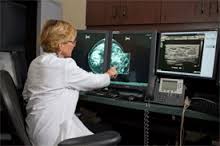and How 3D Mammography Offers Improved Accuracy
In some of our recent blogs, we have discussed how 3D mammography can be more accurate in detecting breast cancer in women with dense breasts. But, what exactly does it mean to have dense breasts?

A doctor examines a digital mammogram of a dense breast and points to a potential cancer
Source: National Cancer Institute
Breast density refers to the ratio of fatty tissue to breast tissue – dense breasts have more breast tissue and less fatty tissue. Usually, the younger a woman is, the denser her breasts are, and the more difficult it is to “see” through the tissue on a mammogram to identify cancer. In fact, this is why mammograms are generally not done until a woman is 40, unless there is a history of breast cancer in her family. However, age is not the only factor. Some women can have naturally dense breasts their entire lives. About 1/3 of women over the age of 50 still have dense breasts.
Breast density is a critical factor that impacts the accuracy of traditional mammograms. Mammograms show images of the interior of the breast in black and white. Fatty tissue shows up as black, while fibrous tissue (or breast tissue) appears white. The denser the breast, the more white appears on the mammogram. The problem is that cancer also shows up as white in mammograms. So, having dense breasts obscures the presence of cancer.
In order to better detect cancer in dense breasts, radiologists are increasingly using 3D mammography, which allows them to get a better view of all the breast tissues. A 3D mammogram is 40 percent more sensitive than a traditional mammogram. So for women with dense breasts, 3D mammography results in fewer false positives and also identifies significantly more cancers than traditional mammograms alone.
A 3D mammogram generates images of the breast using technology similar to CT scans. Unlike traditional mammograms – which compress the breast and take images from only the front and side – a 3D mammogram takes multiple X-rays while moving across the breast in an arch. It takes just a few seconds longer than regular mammograms, and patients generally experience no more physical discomfort than with a traditional mammogram.
The FDA originally approved 3D mammography to be used in conjunction with traditional mammograms for breast cancer screenings. But in 2013, the agency determined that 3D mammography was accurate enough to be used as a standalone test.
As one of the only providers of 3D mammography in the Miami area, the Center for Diagnostic Imaging encourages all women with dense breast tissue to talk to their doctors regarding 3D mammograms and whether this cancer screening tool is right for them. It is an important breakthrough in early detection technology which has been proven to save lives.





